Along the lines of the ‘Carbon Mic’ (see earlier post) are these early horn speakers. They are visual icons that have become separated from their actual sonic function due to the fact that they do not interface with any other audio equipment that any normal living person would own. But don’t those things look great? yes they do. They look very similar to the acoustic horns that are mechanically coupled to the needles of ancient record players, but in fact these are electrical.
here’s an example of a very old record player which has a horn mechanically coupled to the needle:
On the other hand, the early electro-mechanical horns were made for use with early Tube radios. They have drivers with permanent magnets attached to the base of the horn. Driver:
These type of speakers date from the 1920s, and they are the earliest common electro-mechanical transducers. I picked up this example, made by Music Master of Philadelphia, at a yard sale.
Here’s the base of the unit, which contains the driver.
i plugged the very frayed cloth-covered wire into an old receiver and… sound! it worked. the volume level was very very low, tho, even with the 50 watt receiver turned up all the way.
Turns out that these early speakers require a slightly different sort of amplifier than we use nowadays. Not surprising. So i built something to do the trick. I describe the process below for those who want all the bloody details. Once i had this thing running properly, tho… the big question… how does it sound? well, when listening to music recorded in the 1920s (like my Blind Willie Johnson), it sounds fine.
Later music sounds pretty bad. and not even in an interesting way. just bad. But old classical and gospel are cool. Hearing those old recordings played back on the same sort of system that folks would have used 90 years ago… wow. it’s fun. I have the horn (and it’s attendant special amplifier) hooked up to an Apple Airport Express which hides in the base of a corner cabinet in our house.
Other rooms in the house have their own full-range systems with their own Airports, so it’s really easy to switch up the playback systems depending on mood etc. Love iTunes on the laptop.
Here’s the tech-y stuff for those of you who care. So why did the speaker not play back at a decent level when used with my old SONY receiver? A quick bit of online research revealed that these old horn speakers have an effective impedance of 1000-2000 ohms. WAY off from the 8 ohm speaker output of a contemporary receiver. Anyhow, to confirm this, i inserted my handy University Sound universal impedance matching transformer (wired to couple 8 ohms to 600 ohms) and what do you know. the speaker worked fine. Decent volume level with the volume knob set at 10’o-clock.
Anyway, rather than run this thing all the time with a giant shitty receiver, i decided to simply build a tiny 5watt tube amplifier with the highest impedance that i could easily generate – 600 ohms. I had some Edcor 5K/600 single-ended transformers lying around from a mic preamp project that i aborted because… well… the Edcors don’t have enough low end response to make a good mic preamp. In this decidedly lo-fi application, though, they work just fine. I used a 6J7 (for the old-timey look) into a 6V6 tube with a 5V rectifier. I initially built the unit with a 6L6, but the edcor was getting REALLY hot (i guess they mean it about the 5watt rating) so i switched the tube to a 6V6 (and changed the cathode resistor appropriately). It runs cool now.
Anyhow, this little amp also has the added feature of two RCA input jacks that passively mix to the input grid of the 6J7. which is a necessary feature since i use this to listen to (stereo) music from iTunes via the Airport Express. Also: super-nerdy but maybe worth mentioning – dig the old ‘screw-lug’ speaker connection. i have been using these a lot lately and i think they add a little charm, even tho they do generally require some dremel-ing to the chassis in order to mount. (i hate the dremel and will do almost anything to avoid it. Greenlee punches 4eva)
If you find one of these speakers for a good price (mine was $25, down from the sellers asking price of $80), and you can confirm that it works, you might want to pick it up. One caveat: i apparently got lucky with the speaker that i bought. Apparently, it’s common in these older units for the magnets to actually have lost their charge, and if that’s the case, they will need to be re-magnetized using wire and very high voltages. Dangerous and irritating. There are a few pages on the web that describe this procedure. It’s pretty incredible to me that this technology is so old that the magnets have lost their charge. crazy. will this happen to all of our permenant magnet speakers some day? will all of those coveted old Alnico drivers be useless at some point? when? 2050? Can’t wait for “The Day The Tone Died” haha i can’t believe i said that…. awful. Hate ‘Tone’ as a synonym for ‘pleasing sound quality in an electric-guitar sound reinforcement scenario.’
Does anyone out there use one of these speaker systems for music listening?
Anyone have a dedicated ‘antique’ system for listening to certain genres/ periods of recordings?

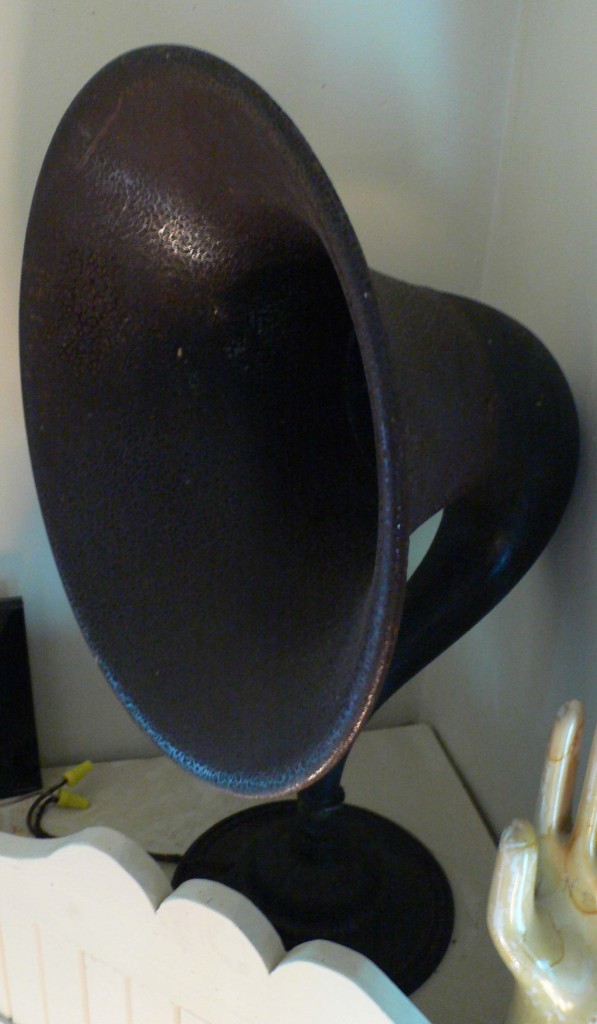
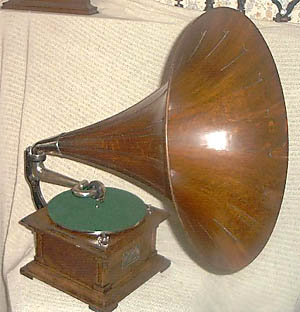
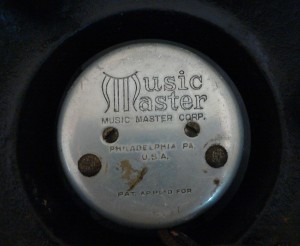
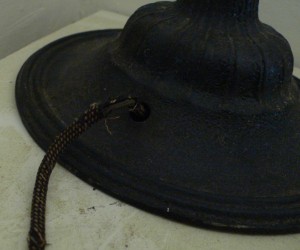
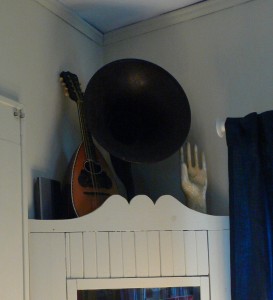
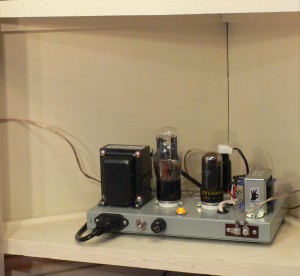
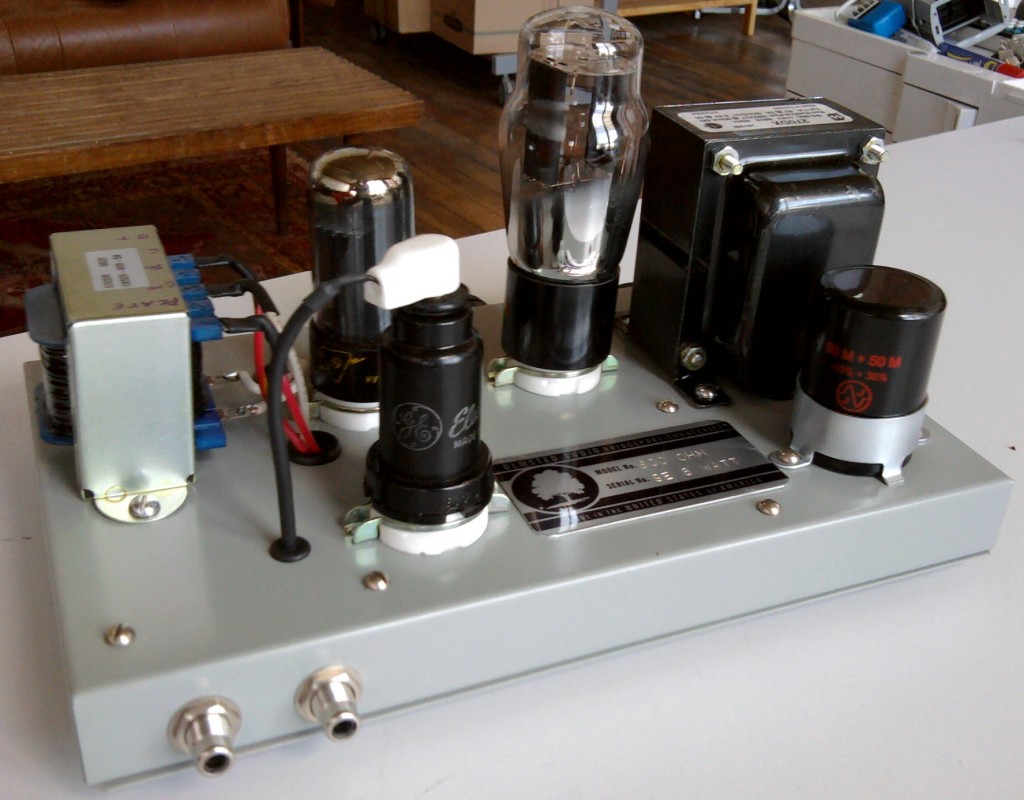
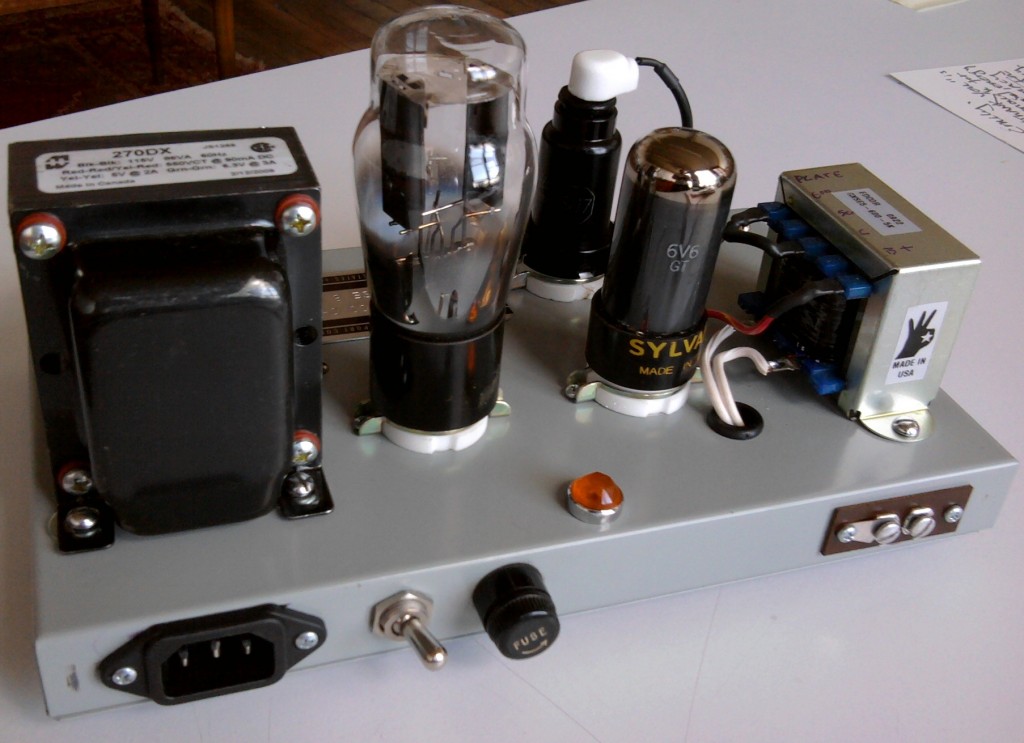
19 replies on “Hey it’s one of those old horn speakers”
found a speaker identical to yours. is it possible to buy a amp like you made ? Would like to hook it up to i pod for my sisters 1920’s house. joe
Could you post a schematic of the amp you made. Maybe a parts list? I’d like to make one of these!I too have a working horn speaker. Right now I’ve rigged it with a small modern speaker inside but id like to do it right!
Hi Jim. thanks for your interest. unfortunately I don’t have the time to make schematics or parts lists – but – fear not; this is an easy task… basically I just built a copy of a Fender 5C1 champ (see HERE for the schem). Not exactly, but close enough. The 5C1 circuit will work fine. ANYways… the crucial change is to use an output transformer that produces a 600 ohm signal rather than a voicecoil-impedance. This will ensure enough voltage to drive the speaker. i used this edcor transfo (GXSE5-600-5K ). it is cheap and it works fine. The left and right channels will mix thru the two 75k resistors to produce a summed mono signal. Good luck.
Oh, no that’s really cool! I’m sorry I know how annoying it can be when someone asks you to do something complicated for free. But this info helps a lot actually!
Very cool stuff. I use an old Webcor turntable, all tube and mono, to listen to my 78’s. It’s one of those all-in-one kind, nice wooden case. Works great and it’s a stack-o-matic style so you can put a few on there and walk away. 45’s you can get like 15 or 20 stacked up.
Would have been simpler to use a 600: 8 matching xfmr, no?
They are common for 70/100V paging audio and for users of Collins KWM-2 and 75S radios.
i mean, yes, sure, that would work fine, but it’s one more thing takin up space on the chassis. i had the edcors lyin around, they fit the bill…. anyway, as i have now come to accept: ANY single-ended output transfo with good low-end response is gonna be expensive. the Lundahl is the cheapest, it’s about $125 for a unit that can handle 10ma. for the 35ma that a 6v6 will draw? Hella expensive.
Okay, so you’ve adapted a modern amplifier to match & drive one of the 1920’s horn speakers….these things are….practically the same, electronically, as the old 2000 ohm radio headphones of the era, & the old horn speakers are notorious for needing to be re-magnetised……
…..So how about twisting this around the other way…..
….How about telling us what kind of setup would be needed to build a modern speaker setup which could be driven by any of the old tuned radio frequency TRF “Neutrodynes”, or regenerative battery sets of that era?
There’s certainly a need for it….when the old speaker drivers on these horn speaker crumble, there’s only so many replacements out there for them.
Hi barry. I imagine that if you simply wired a 70v : 4ohm voicecoil transformer in between the 2000 ohm set and an 8 ohm speaker it would work fine.
I’ve been using Radio Shack miniature Audio Output Transformer 273-1380 on different horns for years. They are 1 K ohm center-tapped to 8 ohms . Ignore the center tap and use 1 K to drive the horn. They are small and can be wired in line on the cord or in a small hobby box. Any old audio xfmr will work. This is quite adequate for demonstration purposes…
I’m not explaining myself well enough.
What modern speaker setup would REPLACE ENTIRELY the old Magnavox/Music Master/RCA vintage radio horn speaker drivers? Preferably the electronic replacement would fit in the base of the old speaker, & since it would be based on a modern Alnico magnet speaker, it wouldn’t need re-magnetizing as the old soft-core drivers now so often do.
I’ve got a classic Magnavox MU-4 right now where the needle connection between the magnet coil & the diaphragm is so messed-up, & the core materials supporting the core windings are so crumbly that it is all but unrestorable….I’m stuck unless I can get an original MU-4 replacement driver which still works, but I would be better off electronically if there were a modern speaker & transformer (universal) replacement for ALL Neutrodynes-Tuned Radio Frequency, & Regeneratives of that early to mid ’20s era.
Hasn’t ANYBODY out there built a modern replacement for these old horn speaker drivers? I think you’d make some money supplying these, like the guy who sells the modern ARBE battery eliminator for these old sets….because what collector of these hasn’t had a horn driver crumble on them, or lose its magnetic charge?
In particular, the Atwater Kent horns are at the bottom of the pile, whereas the Magnavox horns were the best then, & sought after now by collectors, but in the end ALL of these will fall apart at some point. Why isn’t anyone filling this need for existing collectors?
hi there
anybody interested I have been building this type of
reproduction hornspeakers for a number of years now,
they measure approx. 20″ high .12″ in dia with a 5″ dia base
can be fitted with pm speaker. for more info
email iandianne@xtra.co.nz
thanks
Nice project but you are in error about the PM magnet. They did not appear until the mid 40’s. They speakers magnets were charged in part by the output, and when they became too weak the horseshoe magnet would be removed to run an electric current through it to remagnatize it.
WRONG! They DID use a permanent magnet – it was just a primitive one. Electro-dynamic speakers, using a field coil and a voice coil, did not come into common use until the late 1920’s, after the horn became pretty much obsolete. The magnets were made of “magnet steel” (an engineering steel with a high amount of cobalt, and smaller amounts of aluminum, nickel, or copper), and were nowhere as good as modern rare earth or ALNICO magnets, but that IS what was used, in early headphones, horns, and in early cone speakers like the Atwater Kent Model “E” and the Peerless Reproducer. The incoming current had NOTHING to do with magnetizing the magnet itself – in fact, that current was quite weak, and was intermittent or pulsating DC (since it was the sound output).
I have an Atwater Kent Model “M” horn speaker, which goes with my Atwater Kent Model 35 radio (made in 1926). The magnet was, indeed, weak, but it does NOT require high voltages to remagnetize these! Just wind a coil of heavy wire around the old magnet and use a car battery. Be mindful of the magnet’s original polarity (test with a compass), and do a test on a metal bar – the direction you wind the wire in affects the polarity, and if you get the polarity wrong the speaker may not work right and you’ll have to start over again…
Whats it sound like for the modern music?
a telephone. a very bad telephone.
It’s a lot simpler to open the old speaker between the base and the horn and then install an 8-ohm 3-inch cone speaker in the base. You’ll get the horn sound with a speaker matched to your modern equipment.
Hi
Sorry that should read 195-A Fada radio
I just bought a Fada TFR radio model 195-A
I’m not sure what type of speaker would work with this radio.
Do I a horn speaker for this radio or something else?